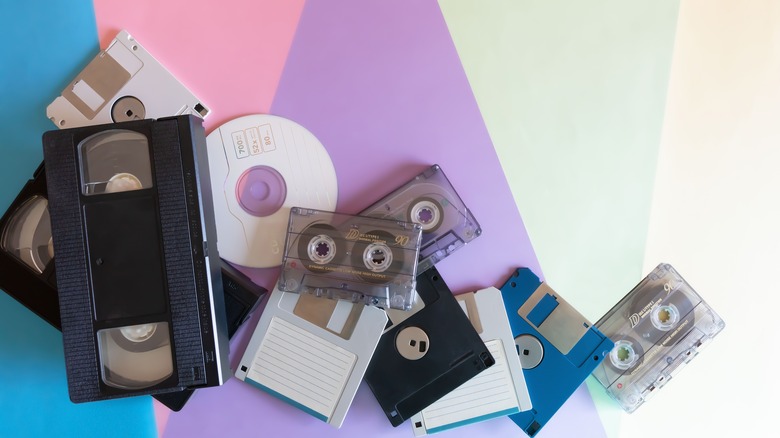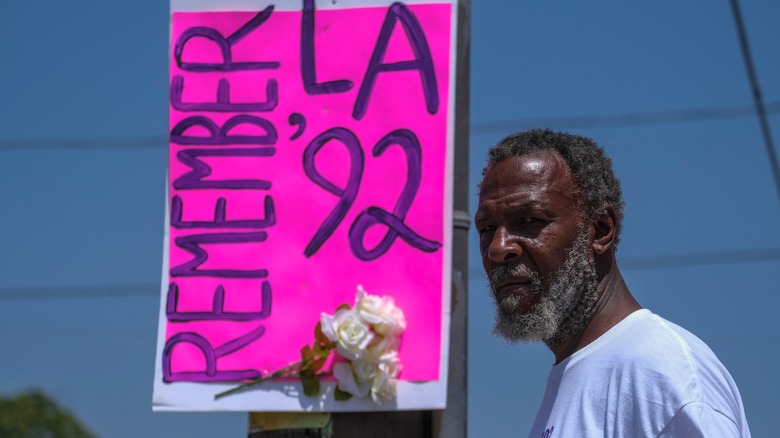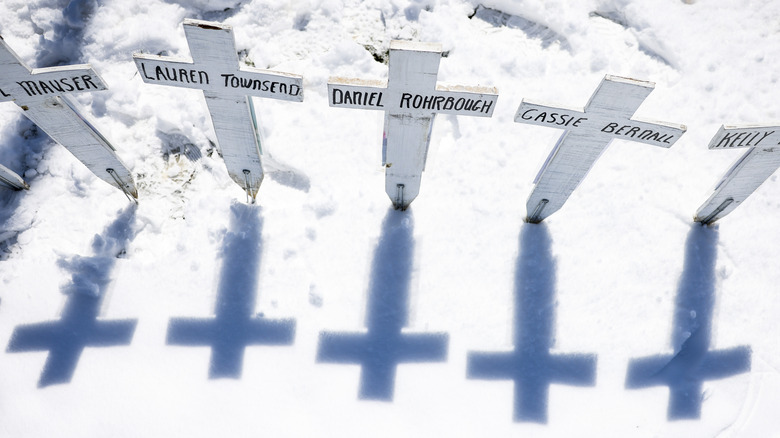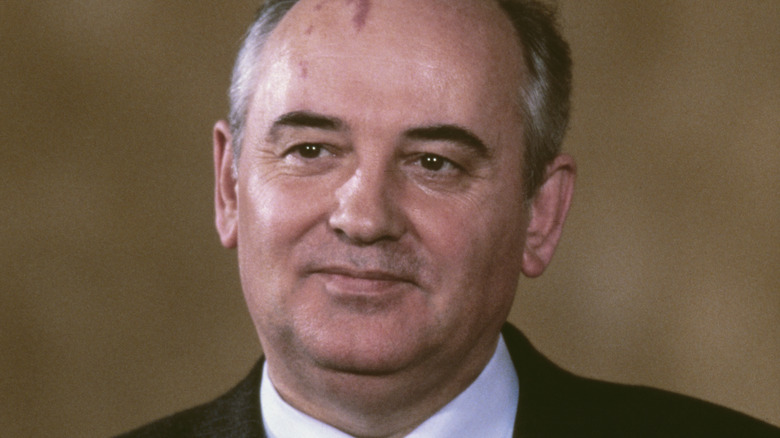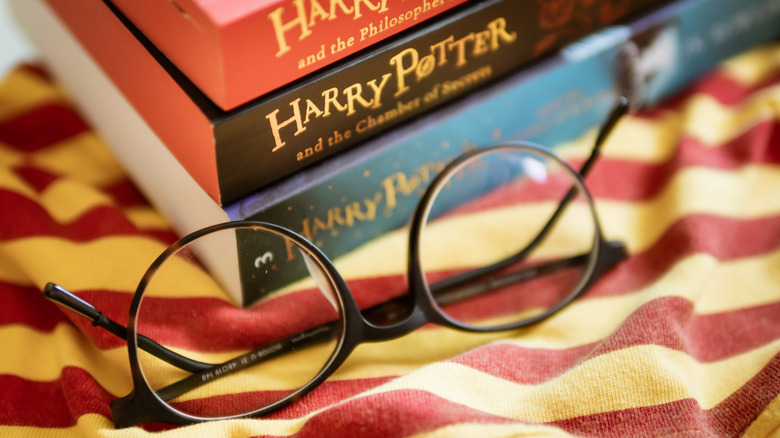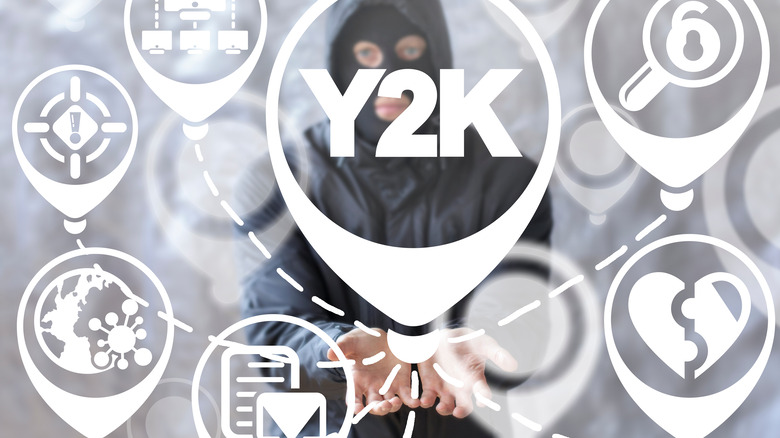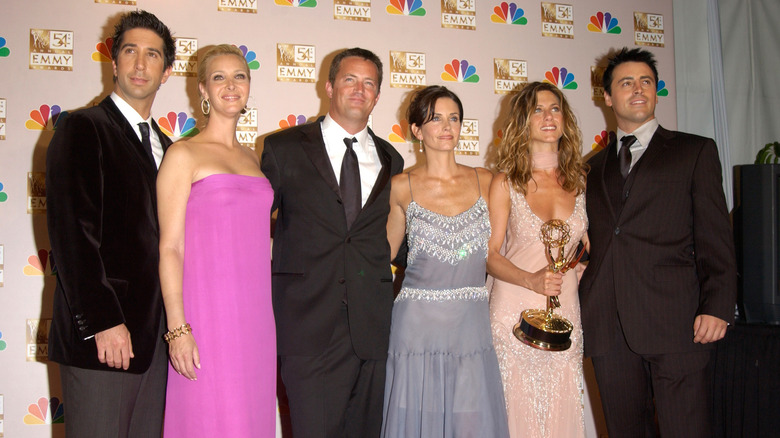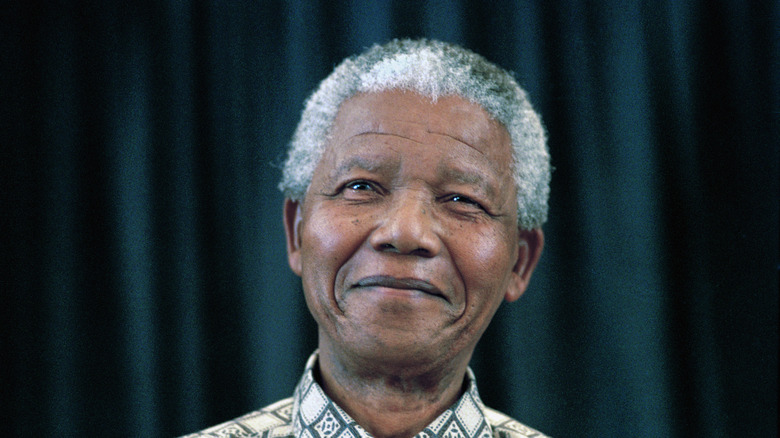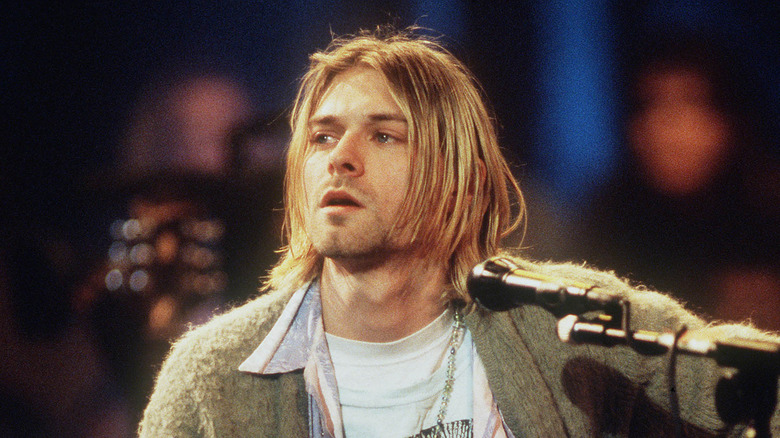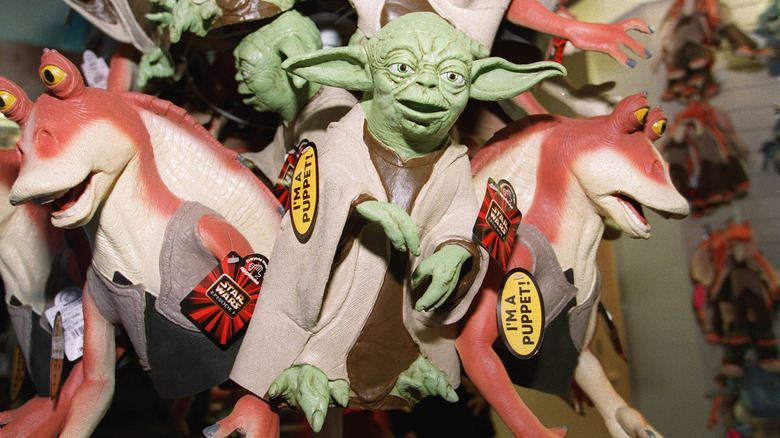Big Moments From The 1990s You Forgot About
Whether you were a fully grown adult in the 1990s or you were just born, you can probably sing the theme song from "Friends" to perfection (and it's probably in your head now). But world-popular American sitcoms aren't the only big events that happened in the 1990s. As History reports, for most corners of the world, the 1990s were a peaceful time — apparently, the Microsoft headquarters had no security back in 1993, and you could just walk by Bill Gates. And peace and prosperity often lead to big developments in science and technology. This is perhaps why you can't say "the 1990s" without saying "the Internet," or the World Wide Web, as per Elon University. Apart from cool rollerskates and VHRs, people now had access to unprecedented amounts of information. This was only the beginning of a series of major breakthroughs.
But not all breakthroughs came out of peace and prosperity. The 1990s was also a decade full of stark reminders that life is not all milk and honey. And while history has a tendency of repeating itself, there was no time like the 1990s. As The New York Times comments, many people feel a burning nostalgia for the decade, whether they grew up in it or not. Let's look at some of the biggest moments from the 1990s you probably forgot about.
The Los Angeles riots
Riots rarely start out of the blue — they're just the last straw. So were the Los Angeles riots. As per History, on March 3, 1991, Rodney King led the police on a car chase while driving under influence. When he was stopped, four police officers — as NPR reports, three of them were white — beat King for 15 minutes straight, to the extent that King was left with a fractured skull, broken bones, and permanent brain damage.
As History notes, Lakeview resident George Holliday videotaped King's beating and sent it to KTLA. People were outraged — this was just one of the many cases of racial injustice and police brutality against minorities in the United States. Adding fuel to the fire was the death of 15-year-old Latasha Harlins, a Black teen accused of shoplifting orange juice who was fatally shot by a Korean store owner, NPR reports. As it turns out, she was just reaching for her money when he shot her.
But on April 29, 1992, after the four officers were charged with excessive use of force, they were all acquitted. Three hours later, one of the biggest riots in American history began. According to History, 2,000 injuries, 12,000 arrests, $1 billion worth of property destruction, and 63 deaths later, the LAPD fired the four officers, two of which served time in prison. The riots were an urgent context for discussing racial inequalities and police harassment of Black communities across the U.S.
The World Wide Web
The internet per se wasn't invented in the 1990s. According to Life Noggin, back in 1962, J.C.R. Licklider laid down the grounds for a network of computers that could send simple messages to each other. By 1969, the ARPANET (Advanced Projects Research Agency Network) was created, connecting four U.S. universities (via Elon University). But it was in 1991 that browsing information on the internet became available to anyone with a connection. That year, Tim Berners-Lee created the World Wide Web — for the first time, you could see information on the computer screen without having to download it first, all thanks to the hyper-text format. As per Britannica, in 2004, Berners-Lee was knighted by Queen Elizabeth II and received the inaugural Millennium Technology Prize by the Finnish Technology Award Foundation.
This was only the beginning of the many developments that followed in the 1990s. In 1992, the very first browser was created: Erwise. A year later, Mosaic came out, programmed by Marc Andreessen and ready to revolutionize internet browsing — by 1996, the internet had 45 million users, as per Elon University.
The Bosnian war
Bosnia-Herzegovina was and is an ethnically diverse country, comprising Serbs, Bosniaks, and Croats (via Britannica). The situation among the groups had been tense for quite some time.
As History reports, Bosnia-Herzegovina declared its independence from Yugoslavia in March 1992, with the United States and Europe recognizing the move in April — the same month as the L.A. riots. So when the Serb-dominated Yugoslav army wanted to send a message to the rebelling Bosnia-Herzegovina, they set out to kill every Bosniak and Croat in the region.
On July 11, 1995, Bosnian Serb forces invaded Srebrenica, one of the last safe havens in Bosnia. The women and girls were put on buses and sent to an army-controlled territory: Many of them were assaulted and imprisoned in the most horrific conditions. The men and boys were taken to mass killing sites — around 8,000 of them lost their lives that day. By August 1995, 100,000 people had died, and 80% of them were Bosniaks. That month, the Serb forces received an ultimatum from the United Nations. When they refused to comply, NATO bombed their military positions and imposed a cease-fire. But it would be a long time until the scars would heal.
Dolly the sheep
Scotland and sheep have been together in sentences for quite some time. But in 1996, they made headlines worldwide: On July 5 that year, the first adult mammal clone was born, and her name was Dolly the sheep (via the Roslin Institute). The clone was produced by biologist Ian Wilmut and his colleagues at the Roslin Institute, near Edinburgh. So how could they tell she was a clone and not just the daughter of her surrogate mom? Well, the biologists chose a black-faced sheep on purpose: If Dolly were genetically related to her mother, she would have been born with a black face, too. But Dolly was all white.
Scientists, embryologists, surgeons, vets, and farmers collaborated on this huge project, hoping to reduce the number of animals used in experiments by replacing them with genetically modified livestock. Dolly was a huge milestone for science, but of course, it also opened up discussions about the ethical nature of cloning. On the one hand, cloning led to the development of personalized stem cells. On the other hand, Dolly was born with shorter DNA telomeres, mimicking those of an older, adult sheep. However, Dolly lived a happy sheep life, until she was euthanized in 2003, following the discovery of a lung tumor.
The Columbine shooting
As CNN reports, in March 1998 — about a year before the Columbine High School shootings, shooter Eric Harris had already shown inclinations of his later crime. Randy and Judy Brown, the parents of high school student Brooks Brown, filed a police report stating that Harris had threatened to kill Brooks. He'd also written online: "All I want to do is kill and injure as many of you ... as I can, especially a few people. Like Brooks Brown." Sadly, nothing came of the report, despite Harris being on the police's radar. On April 20, 1999, Harris and a fellow student, Dylan Klebold, burst into Columbine High School and fatally shot 12 students and a teacher, injuring 23 others. Then, they turned the guns on themselves and took their lives.
In the aftermath of the bloodbath, it was discovered that Harris and Klebold had also planted two propane bombs in the school cafeteria, but they had failed to detonate (via History). At the time, Columbine was the worst school shooting in U.S. history. Needless to say, this generated a lot of discussions around gun ownership laws and school security. The shooters' motivation was debated for years, and as their journals were studied, bullying, depression, and an obsession with the Oklahoma City bombing were cited as potential factors.
The dissolution of the Soviet Union
After World War I, the Bolsheviks seized power and property in the Russia Empire, justifying it as a better system than capitalism and a way to make the Soviet Union the most prosperous country in the world (via Britannica). On the contrary, as the New York Post states, communism is proven to be detrimental to countries, increasing poverty and causing many other socio-economic issues.
The Soviet Union engulfed 15 nations and spread communism to others. Millions of people lived in extreme poverty (bar the very few who made up the ruling class), and as per All That's Interesting, under Joseph Stalin's rule, between 9 and 60 million people lost their lives, many of them starving in frozen concentration camps. On top of this, a cold war between the USSR and the U.S. lingered on for decades.
But in 1991, it was all going to come to an abrupt end. After Mikhail Gorbachev became the Soviet Union's president, he began a reform meant to put an end to communism in Eastern Europe. In 1991, Gorbachev survived a failed coup, thanks to his democratization efforts (soldiers and civilians who had voted for him protected him from the plotters).As Britannica notes, this failure marked the end of communism, and the nations making up the USSR set a course for independence.
On Christmas Day that year, Gorbachev resigned as USSR president, and Boris Yeltsin became the first president of the independent Russian state.
Harry Potter became an international sensation
In 1990, budding British author Joanne Rowling had some time on her hands. Her delayed train to London's King's Cross station would become a rather productive trip in which she created the world of "Harry Potter," as per Insider. Five years later, as a single mom living on benefits, Rowling pitched her first novel, "Harry Potter and the Philosopher's Stone," to 12 publishing houses. All 12 rejected her. Finally, in the summer of 1997, the book was published by Bloomsbury, as Wizarding World reports. But when literary agent Christopher Little accepted Rowling's book, Insider reports he suggested she pick a male pen name, or at least hide that she was a woman, for fear boys wouldn't read the book. This is how Joanne Rowling became J.K. Rowling.
The first "Harry Potter" book was met with immediate acclaim around the world, triggering the creation of six more books, eight films, according to Game Rant, and a billion-dollar franchise. "Harry Potter" is still hugely popular today.
The Y2K panic
When the new millennium was approaching, programmers started to worry about a potential flaw, as National Geographic reports. When engineers designed the first computers back in the 1960s, they used the last two digits of the year to represent the date, creating the famous DD/MM/YY format so as to save a lot of data storage. But they didn't envision what would happen after December 31, 1999. When January 1, 2000, would come along, would computers show 00? And would that mean 2000 or 1900? By the 1990s, airports, banks, and transport systems operated with computers, and showing the right date was crucial for a myriad of reasons.
In preparation, the U.S. spent millions of dollars trying to resolve this bug — called simply the Y2K bug — before the clock stroke midnight on New Year's Day 2000. But it wasn't just the government who was panicking. As Forbes reports, survivalists and end-times Christians made Y2K into an end-of-the-world scenario, urging people to panic buy in preparation for the apocalypse. Funnily enough, when the clock did strike midnight on January 1, 2000, neither the U.S. nor the many countries who made no preparation whatsoever suffered. The simple bug was easy to correct, and of course, there was no apocalypse.
Friends debuts
As History reports, on September 22, 1994, a fresh TV series debuted on NBC. It was called "Friends," and it featured six 20-somethings spending an awful lot of time in the Central Perk cafe, discussing topics in a light manner. After the premiere, the Hartford Courant commented, "The dialogue generally goes like this: 'I don't know whether I'm hungry or horny.' Anemic and unworthy of its Thursday-night time slot." But a survey commissioned by YouTube (via Study Finds) concluded that "Friends" is the most beloved TV series ever, with 43% of those interviewed listing "Friends" as their favorite show. And as per You Gov America, 69% of Americans have seen at least a few episodes of the iconic show. Then, on May 6, 2004, over 50 million people tuned in to watch the series finale, as per History.
But it didn't just stop in 2004. In 2022, the show is still widely popular — the 2021 "Friends: The Reunion" says it all. And on International Friendship Day 2022, Warner Bros. Discovery launched "Friends Fan Week," which featured immersive experiences in Denver, Toronto, and New York (via Variety). While "Friends" might seem a little outdated for today's television, the show created staples of 1990s culture and fashion that still stick with many of us today.
Google was launched
As per Google, founders Larry Page and Sergey Brin met at Stanford University in 1995, while Page was touring the school as a potential graduate student. Within a year, they developed a search engine that sorted individual pages on the World Wide Web by importance and/or relevance. It was called ... BackRub. By 1998, the search engine had been renamed Google and had gained enough momentum to attract Silicon Valley investor Andy Bechtolsheim. He wrote Page and Brin a check for $100,000 and, on September 4, Google became Google Inc.
As Britannica reports, Google is a misspelling of googol, which is a mathematical expression for one followed by a hundred zeroes. This goes to show both Google's playful, open-minded ethic as well as their promise to offer the world a user-friendly, effective search engine. Today, Google is the most-used search engine, with more than 70% of worldwide online search requests coming through the platform. Google also owns Gmail, YouTube, and Android, just to name a few services that are crucial to millions (if not billions) of people.
Nelson Mandela's release from prison
As History reports, Nelson Mandela was once a young lawyer who was fiercely fighting to end the horrible apartheid that had started in 1948 in South Africa. In 1952, he became the deputy national president of the African National Congress (ANC), which was a group of peaceful protesters (via History). But when 69 peaceful protesters were massacred in Sharpeville in 1960, Mandela set up a paramilitary branch of the ANC.
In 1962, Mandela was arrested for leaving the country and sentenced to five years in prison. But two years later, he was put on trial again and sentenced to life imprisonment for sabotage. He would spend 27 years in jail, 18 of which were spent in a small cell with no bed. In 1990, the ANC was unbanned, and Mandela was finally released from prison. Three years later, he would receive the Nobel Peace Prize alongside South African President F.W. de Klerk, who freed Mandela. During his speech, Mandela said, "Let the strivings of us all prove Martin Luther King Jr. to have been correct when he said that humanity can no longer be tragically bound to the starless midnight of racism and war."
Kurt Cobain dies by suicide
When journalist Michael Azerrad met Kurt Cobain in 1992, he had a strange feeling that Cobain would die young, according to the New Yorker. Apparently, so did Nirvana drummer Dave Grohl, Courtney Love, and his own mother. Sadly, they weren't wrong. Cobain had struggled with depression and crippling stomach pain throughout his whole life. So when Love introduced him to heroin, as per Biography, he was glad to try it out — he would have tried anything that alleviated his pain.
From there, it was all downhill. Cobain's friend Greg Sage said fame contributed to it all (via History): "Success to him seemed like, I think, a brick wall." On April 8, 1994, after very nearly surviving an overdose, Cobain took his own life inside his home. Cobain and Nirvana had been at the heart of 1990s culture: They had created a revolution that influenced music, fashion, and embraced vulnerability as an acceptable state of mind.
If you or anyone you know is having suicidal thoughts, please call the National Suicide Prevention Lifeline at 1-800-273-TALK (8255).
Star Wars returns
Technically when "Star Wars" creator George Lucas began the franchise, the first three movies were sequels (via Disney). At the time, no prequels had been made, and there were no plans for it, as far as viewers knew. After "Star Wars: Return of the Jedi" was released in 1983, years passed and "Star Wars" fans wondered if that was really it. But not all hope was lost. As the official Star Wars website states, the 1990s saw a "Star Wars" frenzy in the United Kingdom, as fans were expecting a prequel trilogy to be released. Plastic ewoks and droids decorated shelves everywhere, and "Star Wars" magazines kept the hype up.
Then in 1999, the prequel trilogy finally began with "Star Wars Episode: The Phantom Menace." This was a defining moment for the 1990s and "Star Wars" alike — "The Phantom Menace" was just the beginning of a world filled with "Star Wars" films, series, games, and events that are hugely popular to this day.
